
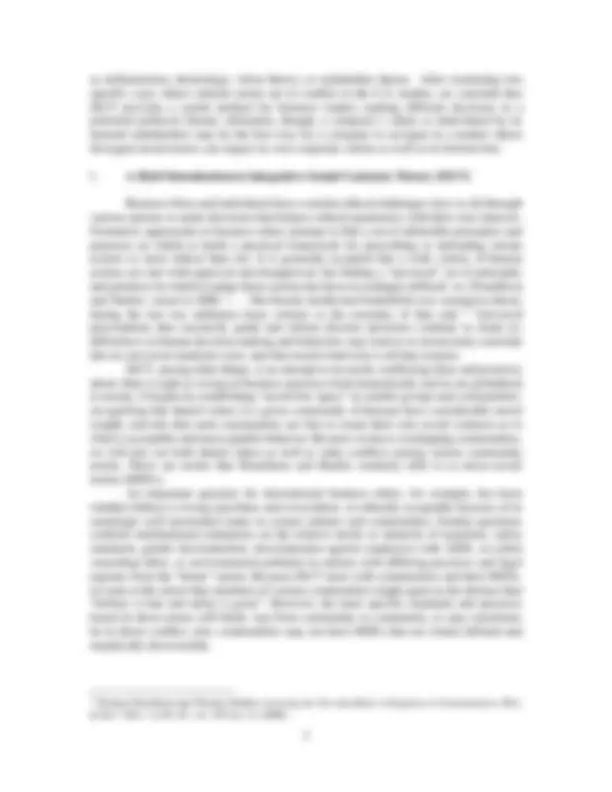
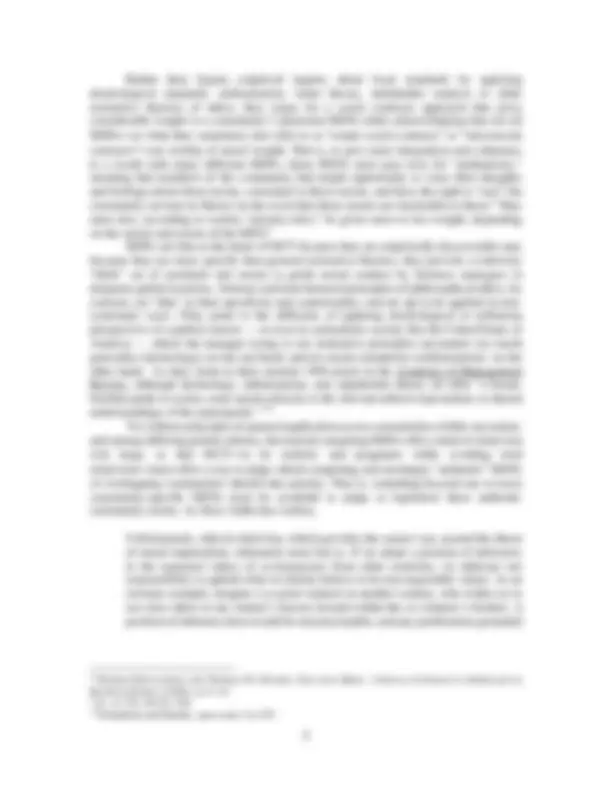
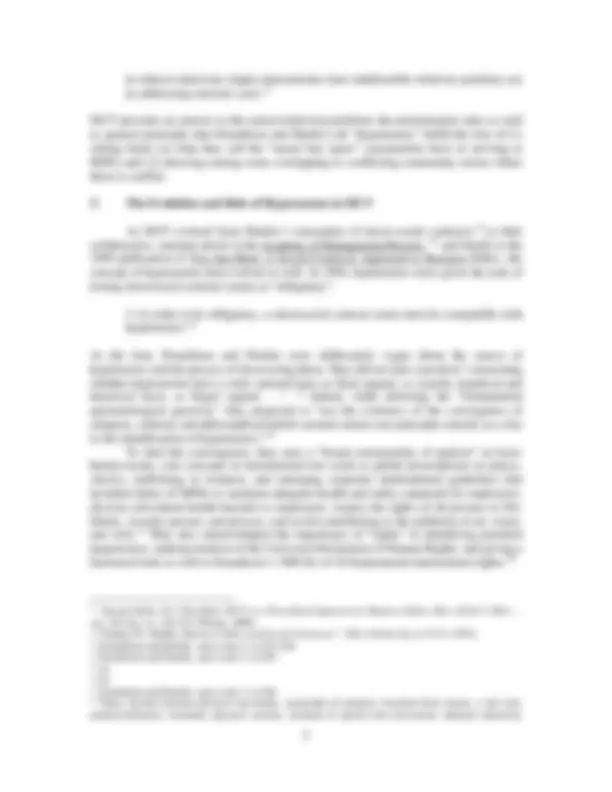
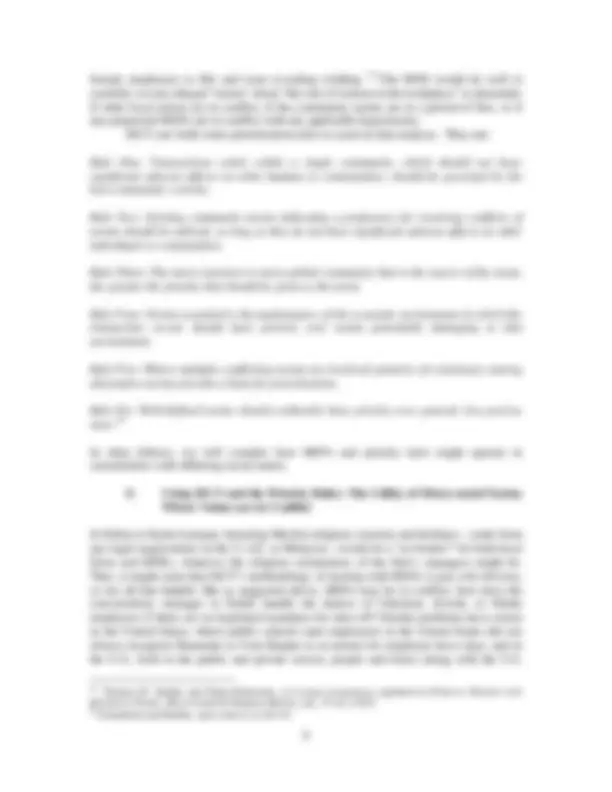
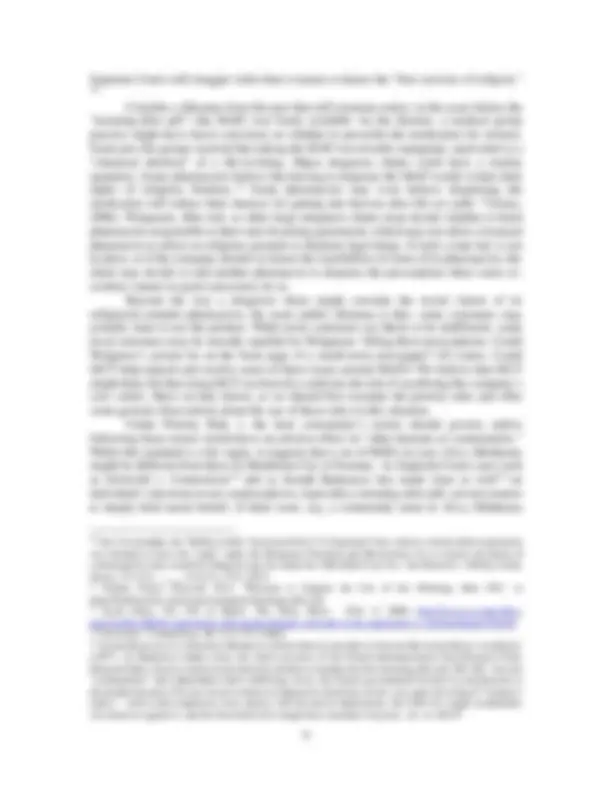

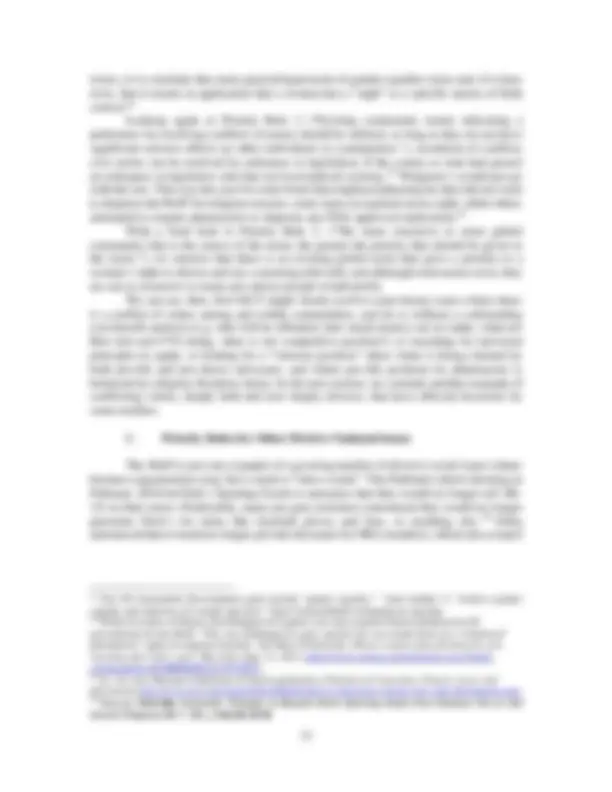
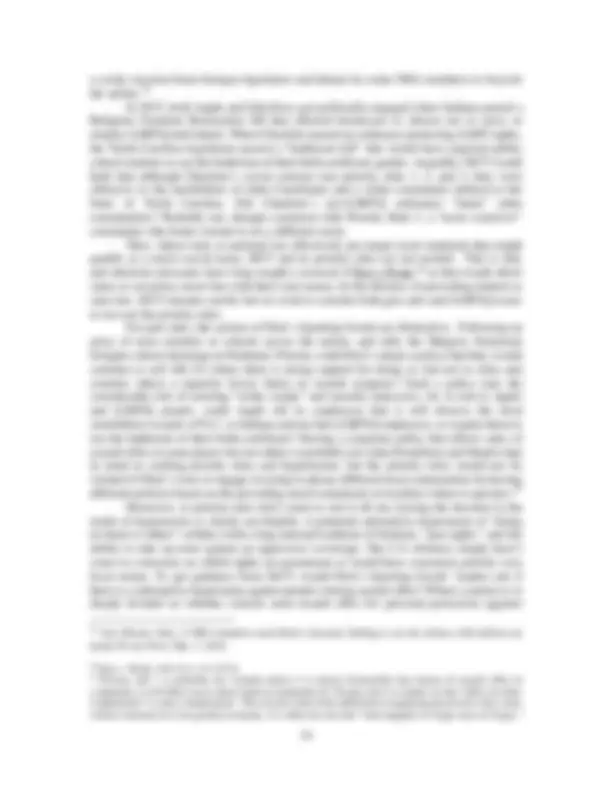
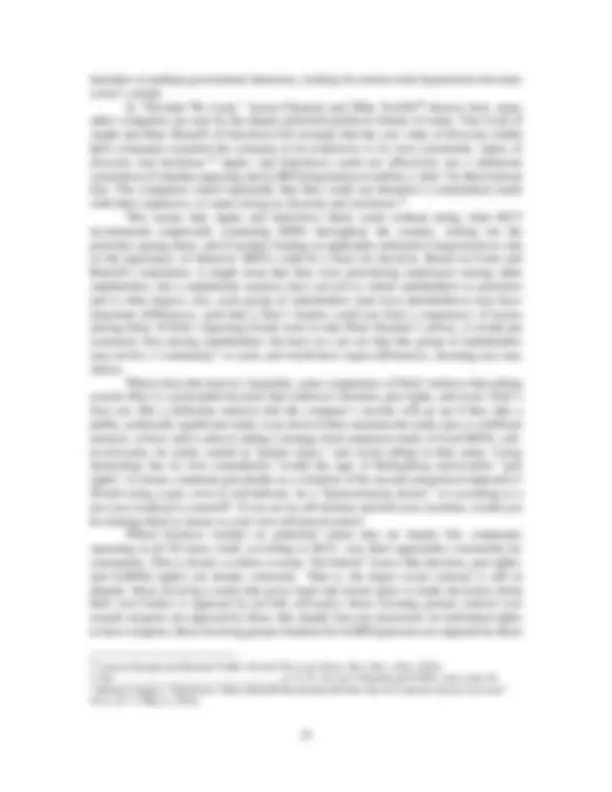


Study with the several resources on Docsity

Earn points by helping other students or get them with a premium plan


Prepare for your exams
Study with the several resources on Docsity

Earn points to download
Earn points by helping other students or get them with a premium plan
Community
Ask the community for help and clear up your study doubts
Discover the best universities in your country according to Docsity users
Free resources
Download our free guides on studying techniques, anxiety management strategies, and thesis advice from Docsity tutors
Integrative Social Contracts Theory (ISCT) and its application in helping business leaders navigate conflicting cultural norms in a polarized political climate. ISCT establishes 'moral free space' within communities and their micro-social norms (MSNs), which must pass authenticity tests and priority rules to provide guidance for moral conduct. how MSNs and priority rules might operate in communities with differing social norms, using examples of Walgreens and morning-after-pills, and pharmacists' religious objections to dispensing certain medications.
Typology: Study notes
1 / 16

This page cannot be seen from the preview
Don't miss anything!










On Integrative Social Contracts Theory (ISCT) and Executive Leadership in a Polarized Political Economy
By
Catharyn Baird, CEO, The Ethics Game Don Mayer, University of Denver
On Integrative Social Contracts Theory (ISCT) and Executive Leadership in a Polarized Political Economy
Conflicting values have created a distinct “polarization” in our body politic,^1 and many business leaders find it difficult to remain neutral in “the culture wars.”^2 Some business leaders have decided to be more politically pro-active, 3 but in some cases, business decisions may alienate customers and other stakeholders. For example, after Dick’s Sporting Goods announced it would no longer sell assault weapons, the retailer was shunned by some customers.^4 In their work on “Integrative Social Contracts Theory (ISCT), Tom Dunfee and Tom Donaldson sought a way for managers to balance conflicting norms and values, creating a synthesis between empirically discoverable community norms and more general normative ethical principles. This, they hoped, would provide more clear and specific guidance for business managers who would otherwise be left with the generic advice of traditional ethical perspectives such as utilitarianism, deontology, and virtue ethics.^5 With so many values and norms in conflict, we here revisit ISCT to see if it can help executives navigate some tricky terrain and deliver on its promise of providing a more specific kind of guidance for business managers. In Part I, we review some basic features of Tom Donaldson and Tom Dunfee’s Integrative Social Contracts Theory (ISCT), particularly the “priority principles” that are designed to provide managerial guidance where existing social norms are in conflict. Part II notes the importance of “hypernorms” to ISCT’s proposed decision-making framework, and Part III returns to the priority rules to see how they would apply as guidelines for U.S. corporate managers facing contentious social issues, including decisions to sell assault weapons, morning-after pills, or take political action on behalf of LGBTQ rights. In the U.S., at a time of “the politicization of everything.”^6 the stakes have become fairly high. Such an environment calls for a more mindful response to existing and conflicting community norms; the priority rules Donaldson and Dunfee propose are the primary way that a firm’s leaders could meaningfully work through those conflicts. As we will see below, using the priority rules can be confusing; yet there seems to be clear benefit in doing so, rather than relying on general theories and frameworks such
(^1) William J. Miller, One Nation... Indivisible? Polarization in America Today , 56 AMERICAN B EHAVIORAL SCIENTIST, vol. 12, at 1607-1611 (2012). (^2) See generally ANDREW HARTMAN , A W AR FOR THE SOUL OF AMERICA : A HISTORY OF THE CULTURE W ARS (2015)(discussing value differences over the nature of the American family, sexual liberation and women’s right, minority rights, public education, the role of religion in society, and how American history should be interpreted). (^3) Aaron K. Chatterji and Michael W. Toffel, Do CEO Activists Make a Difference?: Evidence from a Field Experiment , Working Knowledge, Harvard Business School, https://hbswk.hbs.edu/item/do-ceo-activists- make-a-difference-evidence-from-a-field-experiment. (^4) Tiffany Hsu, Dick’s Sporting Goods Shifts From Guns Even as Sales Suffer , N.Y. T IMES, March 12, 2019. https://www.nytimes.com/2019/03/12/business/dicks-sporting-goods-stock-gun-control.html (^5) Thomas Donaldson and Thomas W. Dunfee, Toward a Unified Conception of Business Ethics: Integrative Social Contracts Theory , ACAD. MGT. REV. vol. 19 (2), at 254-55. (^6) Wall Street Journal, “The Politicization of Everything,” (editorial) Eastern edition, 25 Sep. 25, 2017, at A.20.
Rather than bypass empirical inquiry about local standards by applying deontological standards, utilitarianism, virtue theory, stakeholder analysis or other normative theories of ethics, they argue for a social contracts approach that gives considerable weight to a community’s particular MSNs while acknowledging that not all MSNsor what they sometimes also refer to as “extant social contracts” or “microsocial contracts”are worthy of moral weight. That is, to give some integration and coherence to a world with many different MSNs, those MSNs must pass tests for “authenticity,” meaning that members of the community had ample opportunity to voice their thoughts and feelings about those norms, consented to those norms, and have the right to “exit” the community (at least in theory) in the event that those norms are intolerable to them.^8 They must also, according to various “priority rules,” be given more or less weight, depending on the nature and extent of the MSN.^9 MSNs are thus at the heart of ISCT because they are empirically discoverable and, because they are more specific than general normative theories, they provide a relatively “thick” set of standards and norms to guide moral conduct by business managers in disparate global locations. Abstract and time-honored principles of philosophical ethics, by contrast, are “thin” in their specificity and contextuality, and are apt to be applied in non- systematic ways. They point to the difficulty of applying deontological or utilitarian perspectives in a global context –– or even in a pluralistic society like the United States of America –– where the manager trying to use normative principles encounters too much generality (deontology) on the one hand, and too much complexity (utilitarianism) on the other hand. As they claim in their seminal 1994 article in the Academy of Management Review, although deontology, utilitarianism, and stakeholder theory all offer “a broad- brushed guide to action, none speaks directly to the relevant ethical expectations or shared understandings of the participants.” 10 Yet without principles of general application across communities within one nation, and among differing global cultures, the myriad competing MSNs offer a kind of relativism writ large, so that ISCTto be realistic and pragmatic while avoiding total relativismmust offer a way to judge which competing and seemingly “authentic” MSNs of overlapping communities should take priority. That is, something beyond one or more community-specific MSNs must be available to judge or legitimize these authentic community norms. As Steve Salbu has written,
Unfortunately, ethical relativism, which provides the easiest way around the threat of moral imperialism, ultimately must fail us. If we adopt a position of deference to the espoused values of co-transactors from other countries, we abdicate our responsibility to uphold what we firmly believe to be non-negotiable values. As an extreme example, imagine a co-joint venturer in another country, who wishes us to use slave labor in our venture’s factory located within the co-venturer’s borders. A position of deference here would be unconscionable, and any justification grounded
(^8) T HOMAS DONALDSON AND T HOMAS W. DUNFEE, T IES THAT BIND : A SOCIAL CONTRACTS APPROACH TO BUSINESS E THICS (1999), at 41-43. (^9) Id., at 170, 184-93, 258. (^10) Donaldson and Dunfee, supra note 5 at 255.
in ethical relativism simply demonstrates how indefensible relativist positions are in addressing extreme cases.^11
ISCT provides an answer to this moral relativism problem: the prioritization rules as well as general principles that Donaldson and Dunfee call “hypernorms” fulfill the role of (1) setting limits on what they call the “moral free space” communities have in arriving at MSNs and (2) choosing among some overlapping or conflicting community norms where there is conflict.
II. The Evolution and Role of Hypernorms in ISCT
As ISCT evolved from Dunfee’s conception of micro-social contracts,^12 to their collaborative, seminal article in the Academy of Management Review, 13 and finally to the 1999 publication of Ties that Bind: A Social Contracts Approach to Business Ethics, the concept of hypernorms had evolved as well. In 1994, hypernorms were given the task of testing microsocial contract norms as “obligatory”:
At the time, Donaldson and Dunfee were deliberately vague about the source of hypernorms and the process of discovering them. They did not take a position “concerning whether hypernorms have a truly rational basis as Kant argued, or a partly empirical and historical basis, as Hegel argued.. .” 15 Indeed, while deferring the “fundamental epistemological question,” they proposed to “use the existence of the convergence of religious, cultural, and philosophical beliefs around certain core principles merely as a clue to the identification of hypernorms.”^16 To find this convergence, they note a “broad commonality of opinion” on basic human needs, core concepts in international law (such as global proscriptions on piracy, slavery, trafficking in women), and emerging corporate multinational guidelines that included duties of MNEs to maintain adequate health and safety standards for employees, disclose job-related health hazards to employees, respect the rights of all persons to life, liberty, security person, and privacy, and avoid contributing to the pollution of air, water, and soils.^17 They also acknowledged the importance of “rights” in identifying potential hypernorms, making mention of the Universal Declaration of Human Rights, and giving a backward look as well to Donaldson’s 1989 list of 10 fundamental international rights.^18
(^11) Steven Salbu, Ties That Bind: ISCT as a Procedural Approach to Business Ethics , BUS. & S OC’ Y R EV. , vol. 105 (no. 4,), 444-451 (Winter, 2000). (^12) Thomas W. Dunfee, Business Ethics and Social Contracts ,” 1 B US. E THICS Q. at 23-51 (1991). (^13) Donaldson and Dunfee, supra note 5, at 252-284. (^14) Donaldson and Dunfee, supra note 5, at 265. (^15) Id. (^16) Id. (^17) Donaldson and Dunfee, supra note 5, at 266 (^18) These include freedom physical movement, ownership of property, freedom from torture, a fair trial, nondiscriminatory treatment, physical security, freedom of speech and association, minimal education,
We see, then, that hypernorms are not all alike. Procedural hypernorms bear a great deal in common with the requirements of consent, voice and exit in establishing authentic micro-social norms. Structural and substantive hypernorms, on the other hand, can provide a useful measure to evaluate the legitimacy of otherwise authentic MSNs (the substantive hypernorms) and the practices and principles of actors within economic systems (the structural hypernorms).^26 But as “hypernorms,” especially “substantive hypernorms,” are very much contested^27 we shall examine in the next section whether MSNs and priority rules, without resort to hypernorms, can help guide leaders in a highly polarized disputes over public domestic policy.
III. Priority Rules and their Application in ISCT
Donaldson and Dunfee acknowledge and emphasize that moral decision-making is contextual and often difficult, and that beliefs about what is right or wrong will conflict or be indeterminate in different communities. That is, MSNs often conflict and can present surprising complexity, so priority rules will be needed to sort out which ones might serve as a guide to managerial decision-making. The first step is for managers to pay close attention to what the local community norms are ––through careful empirical study and a healthy dose of skepticism––before concluding that local norms require a particular approach or action.
A. Identifying Micro Social Norms
ISCT’s first steps require a clear understanding of applicable laws, and also of authentic MSN, in places where the firm seeks to do good business. We would suppose, for example, that the thoughtful multinational manager in a Muslim nation will almost certainly decide to honor Muslim calls to prayer and Muslim holidays and would allow any female employees (should there be any) to wear “head scarves.” In Muslim nations that do not allow alcohol, the observant manager will choose to honor local law and custom (the MSNs) rather than hosting a Christmas party with lots of alcohol (illegal) and a scantily clad woman in a Santa Claus suit (possibly legal, but a violation of local norms). Likewise, in a predominantly Christian nation, the thoughtful manager will honor Christian holidays and personal expressions of belief, whether that may be legally required or customary. When Toyota began manufacturing in the U.S., for example, it had to adjust to American laws and customs regarding the free exercise of religion. ISCT advises empirically based caution around coming to conclusions about local customs, or how the law may be routinely interpreted. For example, suppose that a Mexico City branch of a North American bank believes that the “macho” culture there requires all
(^26) There is still some confusion over whether hypernorms are to be used to evaluate practices and actions, or just to evaluate otherwise authentic MSNs. Given Donaldson and Dunfee’s descriptions of structural hypernorms, we believe that they mean to evaluate both seemingly authentic MSNs, but also specific actions that may derogate from the duties that a fair and efficient economic system imposes on business practitioners. (^27) Andreas Scherer, Can Hypernorms Be Justified? Insights From A Discourse-Ethical Perspective , BUS. E THICS Q.(Oct. 2015), at 489-516.
female employees to flirt and wear revealing clothing 28 The MNE would do well to carefully vet any alleged “norms” about “the role of women in the workplace” to determine if other local norms are in conflict, if the community norms are in a period of flux, or if any purported MSNs are in conflict with any applicable hypernorms. ISCT sets forth some prioritization rules to assist in that analysis. They are:
Rule One: Transactions solely within a single community, which should not have significant adverse effects on other humans or communities, should be governed by the host community’s norms.
Rule Two: Existing community norms indicating a preference for resolving conflicts of norms should be utilized, so long as they do not have significant adverse effects on other individuals or communities.
Rule Three: The more extensive or more global community that is the source of the norm, the greater the priority that should be given to the norm.
Rule Four: Norms essential to the maintenance of the economic environment in which the transaction occurs should have priority over norms potentially damaging to that environment.
Rule Five: Where multiple conflicting norms are involved, patterns of consistency among alternative norms provide a basis for prioritization.
Rule Six: Well-defined norms should ordinarily have priority over general, less precise ones.^29
In what follows, we will consider how MSNs and priority rules might operate in communities with differing social norms.
B. Using ISCT and the Priority Rules: The Utility of Micro-social Norms Where Values are in Conflict
In Dubai or Kuala Lumpur, honoring Muslim religious customs and holidays––aside from any legal requirements in the U.A.E. or Malaysia––would be a “no brainer” for both local firms and MNEs, whatever the religious orientations of the firm’s managers might be. Thus, it might seem that ISCT’s methodology of starting with MSNs is just a bit obvious, or not all that helpful. But as suggested above, MSNs may be in conflict: how does the conscientious manager in Dubai handle the desires of Christian, Jewish, or Hindu employees if there are no legislated mandates for time off? Similar problems have arisen in the United States, where public schools (and employers) in the United States did not always recognize Ramadan or Yom Kippur as occasions for employee leave days, and in the U.S., both in the public and private sectors, people and firms (along with the U.S.
(^28) Thomas W. Dunfee and Diana Robertson, A Foreign Assignment , reprinted in E THICAL T HEORY AND BUSINESS (T OM L. BEAUCHAMP & NORMAN BOWIE, eds., 5th^ ed. (1997) (^29) Donaldson and Dunfee, supra note 8, at 184-93.
against non-marital sex or marital sex without procreation––and especially extinguishing a human life with a “chemical abortion” process––that would not affect individuals or communities elsewhere. Priority Rule 1 seems to allow Walgreen’s not to sell contraceptives (or magazines that would offend local sensibilities) if other communities would be unaffected, or without “significant adverse effects.” Likewise, drugstores might decide to sell condoms to people under 18 years of age in New York City, but would avoid doing so in Alva, Oklahoma. Under Priority Rule 2, they invoke local rules for resolving conflicts among norms. The conflict might, for example, be one between freedom to exercise religious beliefs versus some competing norms of “sexual freedom” or “ownership” of one’s body, as either a feminist or libertarian perspective might argue for. As there may be no local rules for resolving such conflicts socially, Rule 2 may inevitably require legal resolution at the municipal, county, or state level. Indeed, some pharmacists in Illinois who wished to exercise their religious freedom––and have the national drugstore chain protect that right– –found that the state licensing process had mandated that they dispense any legal, FDA approved substance prescribed by a doctor licensed by the state. Priority Rule 3 suggests that the more widely held the norm, the greater would be its weight. In this situation, all consumers in the country would have to have a concern about the safety of the drug itself for the norm to be invoked. In this case, concerns about safety have been met because the drug has been through a rigorous testing process and a national body, the Federal Drug Administration (FDA), has deemed the drug safe in particular situations. Walgreens would then be well within the local norms of providing only FDA approved drugs with a prescription which people could access or not. Walgreens also does not have a legal obligation to stock every FDA drug in its formulary, even if a local doctor would prescribe it. The local community norms can give the company some direction about what drugs to make available to the community, unless state law were to require pharmacies to make all FDA approved drugs available. Priority Rule 4 seems not to apply to the above situation, as the “maintenance of the economic environment” does not depend on whether a small-town Walgreens stocks the MAP, or certain magazines deemed offensive to local sensibilities. Priority Rule 5 addresses “multiple conflicting norms” in “very complex situations,” with “many communities with diverse norms having some connection to the transaction.”^35 Donaldson and Dunfee elaborate on this rule by discussing Royal Dutch Shell’s decision to dismantle the Brent Spar oil platform in the North Sea. But selling MAPS in various communities in the United States is different in scope and kind. There are conflicting norms, of course, but the pattern of consistency (as in our second example) has more to do with rural vs. urban divide, and does not offer a multiplicity of community norms in conflict. In the Brent Spar example, they point to oil and fishing industry norms, the norms of nations with coastal ecosystems, the scientific community, as well as jobs- related considerations for nation-states such as Norway and the U.K. Priority Rule 6 would give priority to “well-defined norms,” so that “a woman’s right to choose” would arguably be more general than strongly held views in the community about sexual recreation without procreation, female pre-marital chastity, and deeply held religious views that chemical abortion takes a life-in-being. Likewise, a more conceptual free market value of “consumer choice” would yield to more specific norms
(^35) Donaldson and Dunfee, supra note 8, at 188.
against choosing to end even a fertilized egg, if such views were commonly held in a given community. With evident “push back” from some pharmacists with religious beliefs that make them deeply troubled in dispensing the MAP, it appears that Rule 6 would favor not offering such items for sale where those norms are prevalent. How do all these priority rules give guidance to a retail drugstore chain considering sales of the MAP? We believe the array of questions in the priority rules are useful in this case, much as they are useful in the past where local drugstores and retail drugstore chains had many choices to make regarding how to shelf and sell items like condoms, cigarettes, alcohol, and pornography. In the small towns where we grew up in the 1950s, a Playboy magazine could only be purchased by adults who requested it from the cashier, who kept copies of the current issue under lock and key behind the counter. Prior to and even after the Supreme Court’s 1960s decisions on pornography, retail stores could decide whether or not to sell Playboy magazine, with or without a plain brown wrapper, place it where customers could view a copy, or even sell the racier Hustler magazine if making them available was consistent with “contemporary community standards.”^36 Thus, in New York City, some sales of “smut” would be allowed, while in most of rural Oklahoma, such sales were infrequent or nonexistent. Likewise, without laws forbidding minors to purchase alcohol, cigarettes, or assault rifles, an enterprise (local or national) would have to decide where to “draw the line.” Similar considerations would apply for sales of tobacco, alcohol, or, today, the sales of “vaping” products. Some years ago, CVS simplified the age of purchase decision by determining that its values required selling no tobacco products at all. 37 Arguably this was entirely consistent with ISCT’s methodology. Majority sentiment in the U.S. had clearly moved against tobacco use; from the 1950s when cigarette smoking was fashionable and before its adverse health effects were well-known, there were few (if any) communities that would have made cigarette smokers to go outside. Smoking was generally allowed in public, Opera stars endorsed cigarettes, and network television was abloom with cigarette ads.^38 The gradual shift against cigarettes–where smokers are now relegated to going outdoors, or in separate, enclosed rooms at some airports, is evidence of a clear shift in social attitudes and norms. Absent a highly unlikely hypernorm affirming peoples’ “right to smoke,” drugstores can look to contemporary community standards to decide appropriate age levels for tobacco sales, whether to sell tobacco products at all, and whether to allow teenagers to buy flavored vaping products such as Juul. 39
(^36) Miller v. California, 413 U.S. 15 (1973)(setting forth the Supreme Court’s test of what is “obscene” and including the criteria that the “average person, applying contemporary community standards, would find that the work, taken as a whole, appeals to a prurient interest.” of the viewer). (^37) Dan Mitchell, CVS decision to stop selling cigarettes no big deal to Big Tobacco. FORBES, Feb. 5, 2014 (^38) Stanford University Research Into the Impact of Tobacco Advertising, http://tobacco.stanford.edu/tobacco_main/index.php (^39) Where the authors live, only convenience stores and smokers’ stores carry Juul. As of 2018, 7-Eleven stores seem to carry Juul, but there could be mounting pressure for them to discontinue doing so. See Shia Levitt, San Francisco to Vote on Ban of Flavored E-cigarettes and Tobacco , NPR, Sunday Edition, May 6,
“Vape Girl” reviews e-cigarettes and related products on her blog, and notes that Walgreens’ nationwide is inconsistent in its offerings, suggesting that what they carry varies from community to community. http://vapegrl.com/e-cigarette-brands-walgreens/ “Not only might you find different e-cigarettes at different Walgreens locations, but you may buy a starter kit one week only to find that your local Walgreens is carrying a different e-cigarette brand the following week.” Id.
exists, or to conclude that more general hypernorm of gender equality exists and, if it does exist, that it means in application that a woman has a “right” to a specific means of birth control.^41 Looking again at Priority Rule 2 (“Existing community norms indicating a preference for resolving conflicts of norms should be utilized, so long as they do not have significant adverse effects on other individuals or communities.”), resolution of conflicts over norms can be resolved by ordinance or legislation. If the county or state had passed an ordinance or legislative rule that survived judicial scrutiny,^42 Walgreen’s would just go with the law. This was the case for some firms that employed pharmacists that did not want to dispense the MAP for religious reasons; some states recognized such a right, while others attempted to require pharmacists to dispense any FDA approved medication.^43 With a final look to Priority Rule 3, (“The more extensive or more global community that is the source of the norm, the greater the priority that should be given to the norm.”), we surmise that there is no existing global norm that gives a priority to a woman’s right to choose and use a morning-after-pill, and although such norms exist, they are not as extensive as many pro-choice people would prefer. We can see, then, how ISCT might clearly resolve some thorny issues where there is a conflict of values among and within communities, and do so without a confounding cost-benefit analysis (e.g. who will be offended, how much money can we make, what are Rite-Aid and CVS doing, what is our competitive position?) or searching for universal principles to apply, or looking for a “virtuous position” when virtue is being claimed by both pro-life and pro-choice advocates, and where pro-life positions by pharmacists is bolstered by religious freedom claims. In the next section, we consider another example of conflicting values, deeply held and now deeply divisive, that have affected decisions by some retailers.
C. Priority Rules for Other Divisive National Issues
The MAP is just one example of a growing number of divisive social issues where business organizations may feel a need to “take a stand.” The Parkland school shooting in February 2018 led Dick’s Sporting Goods to announce that they would no longer sell AR- 15s in their stores. Predictably, many pro-gun customers announced they would no longer patronize Dick’s for items like baseball gloves and bats, or anything else. 44 Delta announced that it would no longer provide discounts for NRA members, which also created
(^41) The UN Sustainable Development goals include “gender equality.” Goal number 5: “Achieve gender equality and empower all women and girls.” https://sustainabledevelopment.un.org/sdgs (^42) While Governor of Illinois, Rod Blagojevich signed a law that required Illinois pharmacists fill prescriptions for the MAP. This was challenged in court, and the law was struck down as a violation of pharmacists’ rights of religious freedom. See Mary Wisniewski, Illinois cannot make pharmacists give 'morning after' pill: court” R EUTERS, Sept. 21, 2012. https://www.reuters.com/article/us-usa-illinois- contraception-idUSBRE88K1D (^43) Id. See also National Conference of State Legislatures, Pharmacist Conscience Clauses: Laws and Information http://www.ncsl.org/research/health/pharmacist-conscience-clauses-laws-and-information.aspx (^44) Maireed McArdle, Customers Threaten to Boycott Dick’s Sporting Goods Over Decision Not to Sell
Assault Weapons , N AT’ L REV., Feb.28, 2018.
a costly reaction from Georgia legislators and threats by some NRA members to boycott the airline.^45 In 2015, both Apple and Salesforce got politically engaged when Indiana passed a Religious Freedom Restoration bill that allowed businesses to choose not to serve or employ LGBTQ individuals. When Charlotte passed an ordinance protecting LGBT rights, the North Carolina legislature passed a “bathroom bill” that would have required public school students to use the bathroom of their birth certificate gender. Arguably, ISCT would hold that although Charlotte’s social contract met priority rules 1, 2, and 3, they were offensive to the sensibilities of other Carolinians and a wider community defined as the State of North Carolina. Did Charlotte’s pro-LGBTQ ordinance “harm” other communities? Probably not, though consistent with Priority Rule 3, a “more extensive” community (the State) existed to set a different norm. Thus, where state or national law effectively pre-empts local standards that might qualify as a micro-social norm, ISCT and its priority rules are not needed. This is why anti-abortion advocates have long sought a reversal of Roe v.Wade,^46 as that would allow states to set policy more line with their own norms. In the absence of prevailing federal or state law, ISCT remains useful, but we wish to consider both gun sales and LGBTQ issues to test out the priority rules. For gun sales, the actions of Dick’s Sporting Goods are illustrative. Following an array of mass murders at schools across the nation, and after the Margery Stoneman Douglas school shootings in Parkland, Florida, could Dick’s adopt a policy that they would continue to sell AR-15s where there is strong support for doing so, but not in cities and counties where a majority favors limits on assault weapons? Such a policy runs the considerable risk of seeming “wishy washy” and morally indecisive. Or, to turn to Apple and LGBTQ people, could Apple tell its employees that it will observe the rural sensibilities in parts of N.C. or Indiana and not hire LGBTQ employees, or require them to use the bathroom of their birth certificate? Having a corporate policy that allows sales of assault rifles in some places but not others is probably not what Donaldson and Dunfee had in mind in crafting priority rules and hypernorms, but the priority rules would not be violated if Dick’s were to engage in trying to please different local communities by having different policies based on the prevailing moral sentiments in localities where it operates.^47 Moreover, as priority rules don’t seem to sort it all out, leaving the decision to the realm of hypernorms is clearly not helpful. A potential substantive hypernorm of “doing no harm to others” collides with a long national tradition of freedom, “gun rights,” and the ability to take up arms against an oppressive sovereign. The U.S citizenry simply hasn’t come to consensus on which rights are paramount or would have consensus priority over local norms. To get guidance from ISCT, would Dick’s Sporting Goods’ leaders ask if there is a substantive hypernorm against people owning assault rifles? Where a nation is so deeply divided on whether citizens need assault rifles for personal protection (against
(^45) Alex Horton, Only 13 NRA members used Delta’s discount: Ending it cost the airline a $40 million tax
break, W ASH. POST, Mar. 3, 2018.
(^46) Roe v. Wade, 410 U.S. 113 (1973) (^47) Priority rule 1 is probably not violated unless it is clearly foreseeable that buyers of assault rifles in community A will likely use or abuse them in community B. Priority rule 2 is similar, in that “effect on other communities” is a key consideration. This reveals some of the difficulties in applying the priority rules, since within a national (or even global) economy, it is often not true that “what happens in Vegas stays in Vegas.”
who are wedded to what they see as Biblical commands about the right relationship between people born biologically male or female. And yet we see that ISCT, unlike utilitarianism, virtue theory, or deontology, give us some revealing methods of inquiry, even if the results of those inquires don’t seem conclusive; we offer the working hypothesis that they are not conclusive where (1) following a variable marketing strategy (as with the MAP) will seem obviously hypocritical, as it would had Dick’s Sporting Goods decided to sell assault weapons in some areas, but not others, and (2) where the internal constituencies and mission statements of a company’s culture cannot compromise its values, as with the decisions of Apple and Salesforce with regard to “bathroom bills” in Indiana and North Carolina.
IV. Conclusion
Ethical leadership remains an art, guided by both science and philosophy. A Kantian analysis might help companies like Delta, Dick’s, Walgreen’s, Apple, and Salesforce determine their own core values as they consider what fundamental principles are important to them. A consequentialist analysis could help these companies determine the impact their decision not to sell certain legal items might have to the well-being of the company. A virtue-based analysis could help a company and their leaders determine what their reputation is in the community and guide a decision based on what is perceived as in their community as being a “good company.” But all these approaches seem incomplete without considering MSNs and what those imply for corporations whose footprint is national, or even global. The priority rules of ISCT help clarify for executives the competing values in diverse communities that they must account for. When an organization is faced with a decision that will be socially or politically contentious, the six priority rules provide a good check against actions that will unintentionally go against the values of particular communities. In an age of ethical pluralism and political polarization, especially within the polarized U.S. market, the standard ethical theories will not provide a fine-grained analysis that ISCT will. Our principal caveat is that the priority rules of ISCT will be less decisive where the company’s mission and values are clearly opposed to local norms (MSNs), no matter how authentic those norms may be. That having been said, the discernment process itself will help in framing the final action being taken by the company. Companies may wisely choose to employ ISCT, along with a clear and distinct appraisal of its core constituencies, as Apple and Salesforce did in opposing anti-LGBTQ legislation. The final action is left to the prudential judgment of the leadership team of the company or the CEO. As executives practice the art and science of ethical decision-making, making clear, prudent judgments in a polarized political economy will become considerably easier.